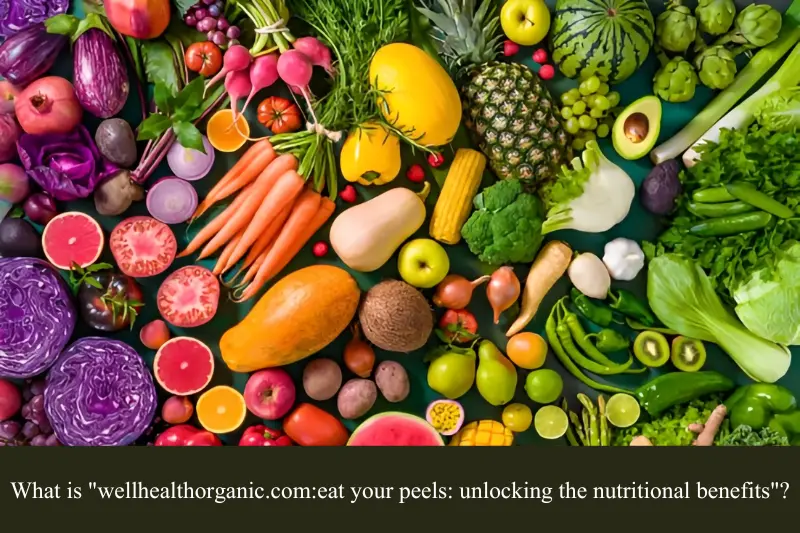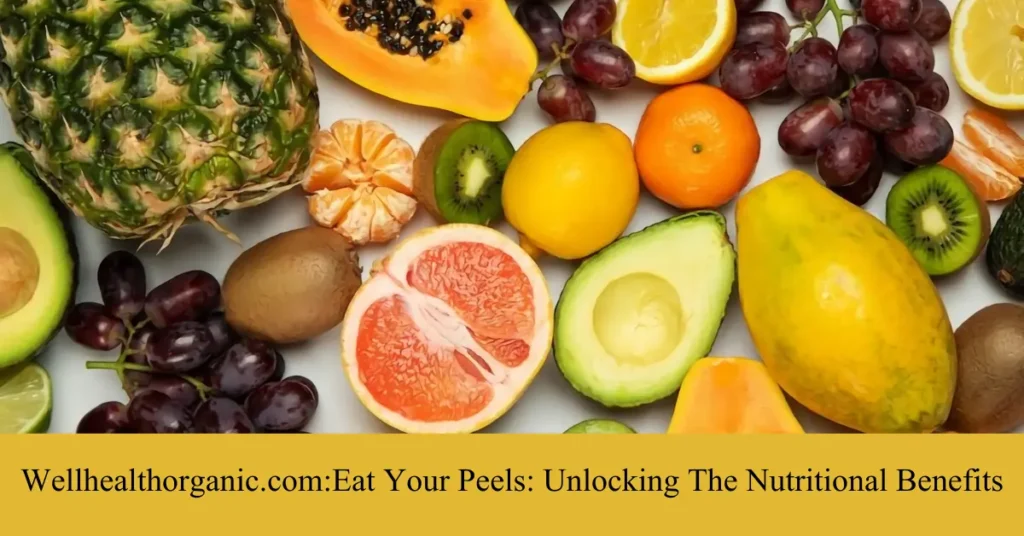Welcome to WellHealthOrganic.com! Today, we’re delving deep into the realm of nutrition with our spotlight feature titled “WellHealthOrganic.com: Eat Your Peels: Unlocking the Nutritional Benefits.“Explore the unexpected health advantages concealed within the peels of fruits and vegetables, and understand why they’re indispensable for your overall well-being. Let’s embark on this journey into the enchanting world of peels together!
What is “WellHealthOrganic.com: Eat Your Peels: Unlocking the Nutritional Benefits”?

At WellHealthOrganic.com, our mission revolves around advocating for healthy dietary habits and maximizing the nutritional worth of your food. Our “Eat Your Peels: Unlocking the Nutritional Benefits” initiative is dedicated to shedding light on the often overlooked nutritional advantages of fruit and vegetable peels.
Many individuals unknowingly discard fruit and vegetable peels without realizing that they harbor a treasure trove of essential vitamins, minerals, antioxidants, and fiber. By incorporating these peels into your diet, you not only minimize food wastage but also enrich your body with vital nutrients that can bolster your overall health and vitality.
Through this initiative, our goal is to educate and empower individuals to embrace the nutritional bounty of peels and seamlessly integrate them into their daily dietary regimen. Whether you seek to fortify your immune system, enhance digestion, or simply infuse more nutrients into your meals, consuming your peels stands as a straightforward and efficacious method to naturally elevate your health. Join us as we peel back the layers and unlock the nutritional benefits together!
Why is “WellHealthOrganic.com: Eat Your Peels: Unlocking the Nutritional Benefits” Important?
Eating fruit and vegetable peels transcends mere trendiness—it embodies a practice brimming with substantial advantages for your health and well-being. Here’s why embracing the nutritional essence of peels holds paramount importance:
Nutritional Value:
- Fruit and vegetable peels boast an abundance of essential vitamins, minerals, antioxidants, and fiber.
- They house invaluable nutrients like vitamin C, potassium, magnesium, and quercetin.
- Consumption of peels amplifies your overall nutrient intake, fostering optimal health.
Reduced Food Waste:
- By consuming peels, you extract the utmost value from every part of the fruit or vegetable, thereby curbing food wastage.
- Diminishing food waste assumes critical significance in sustainability and environmental conservation endeavors.
- Embracing peels fosters a mindful and eco-conscious approach to consumption.
Enhanced Digestion:
- The fiber content in fruit and vegetable peels bolsters robust digestion and facilitates regular bowel movements.
- Consuming peels aids in averting constipation and nurturing a flourishing gut microbiome.
- Fiber-rich peels confer a sense of satiety, aiding in weight management.
Immune System Support:
- The antioxidants nestled within peels combat oxidative stress and fortify the immune system.
- Consumption of peels may mitigate the risk of chronic ailments such as heart disease and cancer.
- Regular integration of nutrient-laden peels augments overall immune function and vitality.
Versatility in Culinary Applications:
- Peels seamlessly assimilate into a diverse array of dishes, imparting flavor, texture, and nutritional richness.
- From smoothies and salads to soups and stir-fries, myriad avenues exist to relish the benefits of peels in your culinary endeavors.
- Experimentation with peels fosters culinary ingenuity and enables exploration of novel flavors.
Cost-Effectiveness:
- Consuming peels enables you to maximize the nutritional potency of your meals sans additional expenditure.
- It constitutes a budget-friendly strategy to amplify your nutrient intake and extract optimal value from your groceries.
- Embracing peels facilitates stretching your food budget while advancing your health aspirations.
In summary, “WellHealthOrganic.com: Eat Your Peels: Unlocking the Nutritional Benefits” assumes paramount significance by championing sustainable eating practices, elevating nutritional intake, supporting digestive health, fortifying immune function, offering culinary versatility, and proving cost-effective. By incorporating peels into your dietary repertoire, you not only nurture your body but also contribute to a healthier planet.
Step-by-Step Guide: “WellHealthOrganic.com: Eat Your Peels: Unlocking the Nutritional Benefits”
Understanding the Benefits:
- Commence by acquainting yourself with the nutritional advantages of fruit and vegetable peels. Familiarize yourself with the vitamins, minerals, antioxidants, and fiber housed within peels and discern how they can underpin your health.
Choosing Organic:
- Opt for organic fruits and vegetables whenever viable to mitigate exposure to pesticides and chemicals. Organic produce typically harbors lower pesticide residues, rendering it safer for peel consumption.
Thorough Washing:
- Before consuming peels, rigorously wash them to eliminate any residual dirt, debris, or pesticide residues. Employ a produce brush or manual scrubbing under running water to cleanse the peels meticulously.
Exploring Culinary Horizons:
- Embark on a culinary voyage with diverse fruits, vegetables, and their respective peels to unearth novel flavors and textures. Ponder integrating peels into an eclectic array of dishes spanning smoothies, salads, soups, stir-fries, and baked delights.
Utilizing Citrus Zest:
- Capitalize on citrus zest! Employ a zester or grater to infuse dishes with the zest of lemons, limes, oranges, or grapefruits for an aromatic burst sans supplemental calories or sodium.
Embracing Innovative Cooking Techniques:
- Cultivate culinary creativity by exploring inventive cooking methodologies for peels. Experiment with baking or grilling potato skins, sautéing carrot tops, or incorporating watermelon rind into salads or pickles.
Minimizing Waste:
- When peeling fruits and vegetables, strive to minimize waste by employing a vegetable peeler or knife to excise solely the outermost layer, conserving as much of the edible portion as feasible.
Overcoming Texture Hurdles:
- Certain peels may exhibit a tougher or fibrous texture, potentially less palatable to some individuals. Experiment with cooking or blending these peels to tenderize them and render them more delectable.
Mixing and Matching:
- Merge diverse fruits and vegetables alongside their respective peels to craft delectable and nutritious meals and snacks tailored to your gustatory inclinations. Blend and juxtapose ingredients to concoct unique flavor amalgamations.
Savoring the Benefits:
- As you integrate fruit and vegetable peels into your diet, monitor your body’s response. Take note of any enhancements in digestion, energy levels, and overall well-being as you nourish your body with these nutrient-dense provisions.
By adhering to this step-by-step guide, you can unlock the nutritional marvels of fruit and vegetable peels and fortify your health naturally. So, roll up your sleeves, unleash your culinary prowess, and commence relishing the bounty of peels today!
Advantages and Disadvantages of “WellHealthOrganic.com: Eat Your Peels: Unlocking the Nutritional Benefits”

Advantages Disadvantages
- Nutritional Powerhouse: 1. Pesticide Residues:
- Abounding in essential vitamins, minerals, antioxidants, and fiber – Non-organic produce may harbor pesticide residues on their peels, posing potential health hazards
- Bolsters overall health and well-being – Risks associated with consuming pesticide residues
- Reduced Food Waste 2. Texture and Taste:
- Harnesses the entire fruit or vegetable, curtailing waste – Certain peels may exude a tough or bitter flavor
- Propels sustainability endeavors – Texture of select peels may prove less appealing
- May necessitate cooking or blending for texture refinement
- Improved Digestion 3. Digestive Concerns:
- Elevated fiber content fosters robust digestion and regular bowel movements – Ingesting copious amounts of fiber-rich peels may induce digestive distress or gastrointestinal discomfort
- Mitigates constipation and fosters a flourishing gut microbiome
- Immune System Fortification 4. Limited Culinary Utility:
- Antioxidants fortify the immune system – Certain peels may offer limited culinary versatility and may not seamlessly complement all dishes
- Alleviates risk of chronic ailments
- Bolsters overall immune function
- Culinary Flexibility 5. Availability and Accessibility:
- Peels seamlessly integrate into a myriad of dishes, enriching flavor and nutrition – Availability of specific fruit and vegetable peels may fluctuate contingent on seasonality and geographical location
- Fuels culinary innovation and exploration – Not all peels may be readily accessible or easily procurable
- Cost-Efficiency 6. Individual Preferences:
- Maximizes nutritional worth sans added expense – Personal taste preferences may fluctuate, with some individuals opting against consuming certain peels
- Budget-friendly approach to health promotion – Individual culinary predilections may influence willingness to incorporate peels into diet
By cognizantly appraising both the advantages and disadvantages of consuming fruit and vegetable peels, you can make informed decisions regarding their integration into your dietary regimen to fortify your health and well-being.
Frequently Asked Questions (FAQs):
Are fruit and vegetable peels safe for consumption?
Indeed, fruit and vegetable peels are generally safe for consumption, provided they undergo thorough washing to expunge any impurities, debris, or pesticide residues. Opting for organic produce further mitigates potential exposure to pesticides.
What are the perks of consuming fruit and vegetable peels?
Consuming peels enriches your nutrient intake, bolsters digestive health, fortifies the immune system, and curtails food wastage. Peels abound in essential vitamins, minerals, antioxidants, and fiber, rendering them invaluable additions to your diet.
Can consuming peels aid in curbing food wastage?
Assuredly! By incorporating peels into your culinary repertoire, you leverage the entire fruit or vegetable, thereby reducing waste and advancing sustainability endeavors. It’s a win-win scenario benefiting both your health and the environment.
How can I incorporate peels into my diet?
Peels seamlessly blend into an array of dishes, including smoothies, salads, soups, stir-fries, and baked goods. Embrace culinary experimentation by exploring diverse fruits and vegetables to uncover novel flavor profiles.
Are there any peels I should avoid consuming?
While most fruit and vegetable peels are safe for consumption, it’s prudent to exercise caution regarding potential pesticide residues, particularly on non-organic produce. Additionally, some peels may boast a tough or bitter taste, potentially deterring certain individuals.
Can individuals with dietary restrictions or allergies consume peels?
Individuals harboring dietary restrictions or allergies should consult healthcare professionals prior to incorporating new foods into their diet, including fruit and vegetable peels. Personalized guidance can be tailored to accommodate specific needs and preferences.
How should I cleanse peels before consumption?
To ensure peels are pristine and fit for consumption, meticulously wash them under running water, employing a produce brush or manual scrubbing. This facilitates the eradication of any dirt, debris, or pesticide residues clinging to the surface.
Can peels from all varieties of fruits and vegetables be consumed?
Although numerous fruits and vegetables boast edible peels, some may prove more palatable or suitable for consumption than others. Experimentation with diverse varieties aids in identifying those you relish and feel comfortable incorporating into your diet.
Are there any cooking techniques to ameliorate the texture of peels?
Indeed, certain cooking or blending techniques can ameliorate the texture of peels, rendering them more palatable. For instance, baking or grilling potato skins tenderizes them, while blending tougher peels into smoothies yields a smoother consistency.
How can I ensure I derive maximal nutritional benefits from peels?
To optimize the nutritional yield of peels, embrace a varied assortment of fruits and vegetables, and regularly incorporate their respective peels into your meals. Remember to cleanse peels thoroughly and savor them as part of a balanced diet.
Conclusion:
In summation, embracing fruit and vegetable peels in your dietary regimen constitutes a judicious choice benefiting both your health and the planet.
These nutrient-rich outer layers proffer an array of advantages, spanning augmented nutrient intake to diminished food wastage.
While considerations such as pesticide residues and individual taste preferences merit acknowledgment, the merits of peels far surpass the demerits.
Hence, do not hesitate to integrate peels into your meals and snacks—tis a simple yet potent means to bolster your well-being and effectuate a positive ecological impact. Let us collectively peel back the layers and revel in the goodness together!
Bonus Points:
Try DIY Fruit and Vegetable Chips:
Transform residual peels into delectable snacks by baking or air-frying them to craft crispy chips. Season with preferred herbs and spices for enhanced flavor.
Craft Homemade Broth or Stock:
Reserve vegetable peels like carrot tops, onion skins, and celery ends to concoct your own nutrient-laden broth or stock. Simmer peels in water alongside herbs and spices for a flavorsome base for soups, stews, and sauces.
Formulate Natural Cleaning Solutions:
Harness citrus peels such as lemon or orange zest to fabricate homemade cleaning solutions. Infuse vinegar with citrus peels to yield a natural cleanser efficacious in dissolving grease and grime.
Compost Unused Peels:
If possessing a backyard compost bin or access to a community composting program, consider composting leftover fruit and vegetable peels. Composting engenders waste reduction and yields nutrient-rich soil for gardening.
Share Your Peeling Wisdom and Recipes:
Disseminate cherished peeling insights, recipes, and inventive applications for fruit and vegetable peels amongst acquaintances, kin, and online communities. Galvanize others to embrace the nutritional merits of peels and diminish food wastage collectively.
Host a Peel-Infused Potluck:
Organize a potluck banquet or culinary soiree with comrades and challenge each participant to devise dishes incorporating fruit and vegetable peels. Unleash creativity and discern who concocts the most exquisite and imaginative peel-centric recipe.
Support Local Producers and Markets:
Procure fruits and vegetables, inclusive of those with edible peels, from local farmers’ markets or community-supported agriculture (CSA) initiatives. Supporting local growers fosters sustainable agricultural practices and ensures fresher, more flavorsome produce.
Initiate a Peel-Preservation Challenge:
Urgently beckon acquaintances, kin, or colleagues to partake in a peel-preserving challenge. Task participants with integrating fruit and vegetable peels into their meals over a stipulated duration and encourage them to share their experiences and recipes.
Delve Into Traditional Peel Utilization:
Explore traditional cuisines and cultural practices integrating fruit and vegetable peels into culinary endeavors. From citrus zest in Mediterranean fare to pickled watermelon rind in Southern cuisine, an array of culinary traditions beckons exploration.
Infuse Artistry Into Garnishes:
Employ fruit and vegetable peels as decorative garnishes for libations, desserts, and savory fare. Citrus twists, cucumber ribbons, and carrot curls
bestow a visual allure and flavor enhancement upon culinary creations.











